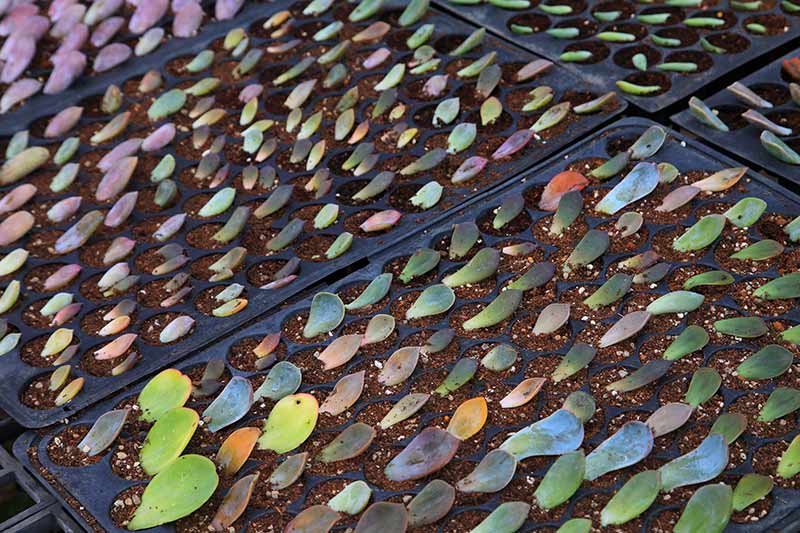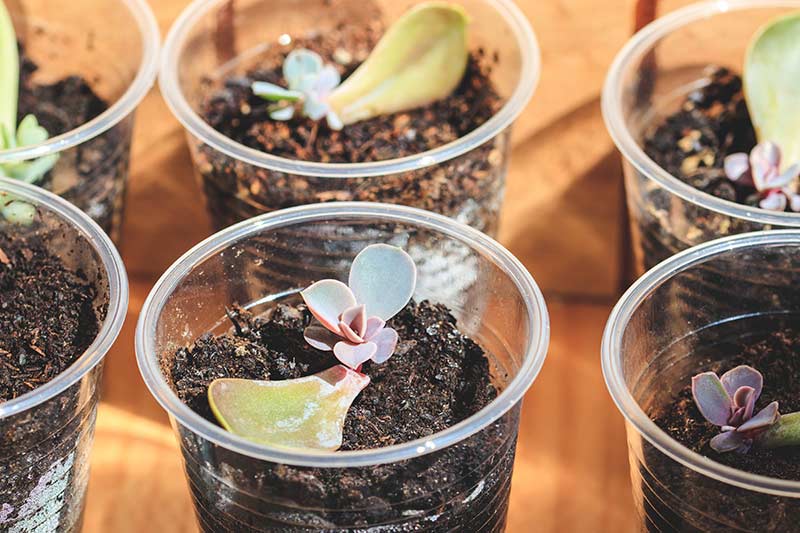How to Grow Succulents from Leaves and Stem Cuttings
With their captivating colors and uncommon forms, succulents are taking the world by storm. Not only are they beautiful, these low-maintenance lovelies are some of the simplest plants to grow. They're also among the easiest plants to propagate from leaves and stem cuttings, even if you've never propagated a plant before. By learning how to grow succulents from leaves and stems, you can expand your collection and impress your friends.

Always allow succulent leaves and cuttings to dry and callus before planting.
Understanding Succulent Basics
"Succulent" is a catch-all name for a plant group that includes thousands of species, some closely related and others not related at all. From cacti, aloes and agaves to sedums, sempervivums and echeverias, their botanical connections vary widely. But one characteristic unites them: Succulents store water in their leaves, stems or roots.
When propagating non-succulent plants such as hydrangea cuttings or rose cuttings, dehydration can cause big problems. With succulents, that's not a concern. Instead, the focus is on keeping leaf and stem cuttings free from rot and fungal disease.2
Because of this difference, whether you're propagating succulents from leaves or stems, allow several days between the time you take cuttings and planting day. Allow the cuttings to dry in a warm, dry place out of direct sun. The open wounds should form protective calluses in three to four days.

Root succulent leaves and cuttings in planting trays or small pots.
Taking Succulent Cuttings
Propagating succulent leaves and cuttings is easiest in spring and summer, when leaves and stems are primed for active growth. Most popular succulents propagate well from individual leaves or stem pieces.
- Leaf propagation works best for succulents with fleshy leaves, such as jade plants or echeveria and sempervivum rosettes. To root successfully, the leaf must stay whole. Grasp the leaf with your forefinger and thumb and gently rock it back and forth to loosen it. Then carefully detach the leaf, with its base intact, from the mother plant.
- Stem cuttings work well for succulents with distinct stems, such as stacked crassulas and spreading or upright sedums. How to cut succulents is similar to soft-stemmed plant propagation. Use a sharp knife to cut stem tips or take an entire stem for multiple starts. Make each cutting 2 to 3 inches long, with several leaves. Keep two leaves at the top and remove the rest.

Roots and new plants form at the base of planted succulent leaves.
Planting Succulent Leaves and Cuttings
Propagating succulents in water is possible, but it goes against the growing conditions these plants naturally prefer. For best results, start your leaves and cuttings in shallow planting trays or small containers filled with potting mix. Individual containers eliminate the need to transplant succulents soon after they root.
While most popular succulents root easily, progress is slow for some types.2 You can speed up the process and improve your results by using rooting hormone.3 GardenTech® brand's RootBoost™ Rooting Hormone stimulates root development and encourages succulent leaves and stem cuttings to develop more uniform roots. That leads to more vigorous, well-rooted plants.
Once your leaves or stem cuttings callus and planting day arrives, follow these simple steps:
1. Prepare your planting containers or trays. Use a coarse, fast-draining potting mix designed for cacti and succulents, and dampen it slightly.2 Use a small stick to make planting holes.
2. Pour a small amount of RootBoost Rooting Hormone into a dish. Pour only what you'll use, and throw away the excess when you're through.
3. Work one cutting at a time. Moisten the leaf base or the cutting stem, then dip it into the dish of rooting hormone. Cover the leaf base or stem thoroughly. Shake off any excess rooting powder.
4. Insert leaves or stems carefully so the rooting powder stays in place. Then gently firm the potting mix around the cuttings.
- For leaves, insert the base at an angle — barely below the soil line. Place curved leaves so they curve upward. (The new baby plant grows on that side.)
- For stem cuttings, insert the bottom half of the stem so the potting mix covers at least two bare nodes.
5. Don't water until roots begin to form. Then water well and let the soil dry out before you water again. Rooting time varies significantly, but most succulent leaf and stem cuttings should root within two to three weeks. Cuttings from stem tips root fastest of all.
6. Replant your new succulents from trays to small containers once roots have established. Use the same type of potting mix that you used before. Take care not to disturb tender new roots.

Grow your new succulents individually or create colorful gardens.
Caring for Your New Succulent Plants
Most mature succulents prefer full to partial sun, but protect new plants from harsh, intense rays. More light can intensify succulent colors, but too much light can cause fading and sunburn. Even in deserts, succulents are often shaded by taller plants.
As your plants mature, you can transplant your succulents to larger pots, combination planters or garden homes. Always ensure your succulents have coarse, loose soil and excellent drainage to keep them healthy and free from rot.
Succulents tolerate heat and drought well, but regular watering keeps water-conserving leaves and stems plump, beautiful and firm. Always let the soil dry out well, then water deeply and thoroughly. Let succulent soil dry out before you water again.
By learning how to root succulent cuttings and leaves, you can step up your succulent plantings and share your extras with family and friends. GardenTech brand is here with premium products and the guidance you need to master succulent propagation and enjoy the results.
Always read product labels thoroughly and follow instructions carefully.
GardenTech is a registered trademark of Gulfstream Home and Garden, Inc.
RootBoost is a trademark of Tech Pac, L.L.C.
Resources:
1. D.L. Mahr, "Some Major Families and Genera of Succulent Plants," University of Wisconsin Extension.
2. G. Voyle, "Secrets to Success When Propagating Succulent Plants," Michigan State University Extension.
3. T. Nightingale, "Propagation—Succulents and Woody Plants," University of California Agriculture and Resources.
Get Monthly Gardening Advice!




